Gestión de Compras has extensive experience in the design, development and manufacture a wide range of pins.
Pins classification
Industrial pins are varieties of fastening hardware. These parts are specially design to resist shear and torsional forces. The function of this component is couple, align, mount, assemble, or penetrate two workpieces with a common hole. The operation of the pin depends on design and employment.
Exist a wide variety of standard pins types and dimensions, as well as special designs to specific applications.
Industrial pins can be categorized in order to his function and forms into several categories, such as: dowel pins, spring pins, cotter pins and wire clips, hitch and lynch pins or special pins.
Dowel pins
Dowel pins are industrial fasteners that are used to join two or more items together. They are short, cylindrical rods that can be made of different materials such as wood, metal and polymer. Exists several types of dowel pins how we can see below:
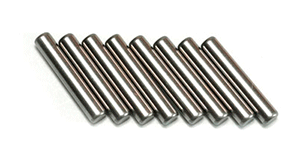
Drive pins
Have an interference fit and must be hammered into a mating hole. They are common for rotary and moving applications.
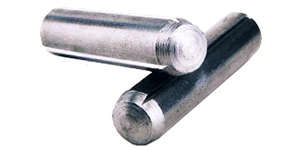
Groove pins
Are engraved with longitudinal or helical grooves. These grooves are meant for adhesives to relieve hydraulic pressure and improve holding.

Knurled pins
Have a knurled surface to improve the pin’s grip. Most of this knurled surface are straight, helical and diamond knurls.

Pull dowel pins
Have a threaded hole at one end so a screw can be inserted. It is specially used to assist the removing of the pin from a blind hole.
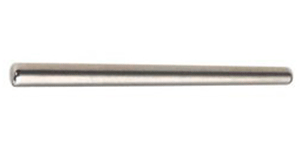
Tapered pins
These pins have the form of a truncated cone.
Spring pins
Spring pins have a body diameter which is larger than the hole diameter. The spring action of the pin allows it to compress as it assumes the diameter of the hole. A spring pin is considered are cost-effectives because the radial force exerted by the pin retains it in the hole prevent loosening created by vibration or shock and requiring less preparation than other types of pins. There are two types of spring pins:
Coiled spring pin
Also called spiral pin, this type of pin presents a great flexibility in diameters, uniform strength and equal stress distribution, also are shock-absorbing fastening elements.
Slotted spring pin
Also known as roll pins, slotted spring pins are headless cylindrical pins rolled from a strip of material with a slot of the entire length to allow the pin to have some flexibility during insertion.
Cotter pins and wire clips
Cotter pins and wire clips are designed to be easy to install and remove. Generally, these clips need to be inserted into a predrilled hole, or applied around a shaft. Is possible produce specific designs to special assemblies to meet the needs of each application. The following are the principal types of them:

Cotter pin
Also called as spin pin, are made of semi-circular wire that is bent over its flattened side to create a rounded head. These pins are meant for one-time application because his deformable tines are used to fasten the predrilled components, being useless for future needs.

Hairpins
Also called as R-clip, have an asymmetrical bulb and wave on one half of the pin. The other half of the pin is straight. This straight leg of the R-clip is pushed into the hole of the shaft. Commonly used to secure the ends of round shafts such as shafts and clevis pins. This type of pin assembles components between the cavity created by the waved and straightened ends, with the assembly held tight by the pin’s elastic deformation.

Twist pins
Share similar mechanical properties with hairpin clips. The difference between hairclip and twist pins are that the last one have a self-locking mechanism.
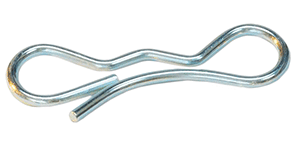
Bowtie pins
Are similar to hairpin clips and twist pins, except the clip wire is formed into a completed circuit. A deformable wire break allows the clip to be applied to a shaft and reduces the risk of being accidentally removed by knocks or vibration.
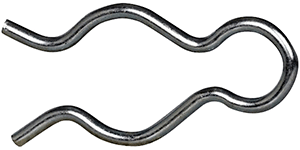
Hairpin clips
Also called retaining pins or omega type, it’s a type of R-clip thinking to provide a positive grip on a grooved shaft.
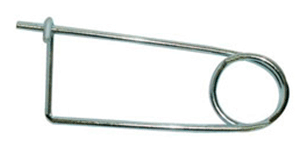
Safety pins
Are wire-wound, and similar in construction and function to household fasteners by the same name. Components are assembled on a straightened side of the clip, with the other side providing a clasp to contain the parts.
Hitch and lynch pins
Hitch pins and their variations are simple forms of hardware used to temporarily mount or conjoin mating components for high requirements purposes than cotter pins. Linch pins are designed to retain a rotating device on its axle, but it can also be used as a fastener as well. Both of these types of pins require predrilled holes in shafts and some form of a lock to be effective.

Hitch pins
Link two mating components and are held in position on one end by the use of cotter pin, and in the other end a bend or handle to prevent removal. This types of pin can reach a significant load always that it won’t be applied on the cotter pin.
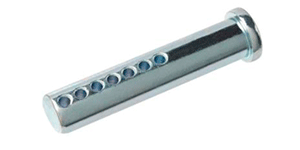
Clevis pin
Is a hardware piece with a head, a cylindrical body and a hole that is routed through a mating clevis fastener to assemble components. This pins are designed to absorb lateral stress and rotate to allow freedom of movement for supported objects. A cotter pin is required to prevent the clevis pin from loosening. Exist universal Clevis pins with several holes for adjust the pin to different applications, as we can see on the right picture.
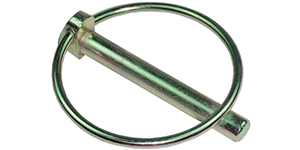
Linch pin
(Also lynch pin or click pin) is a fastener specially designed to prevent a wheel or other part from sliding off the shaft. Employs a locking ring attached to the head that fastens the pin in place. This loop snaps down hard to hold the fastener in place.
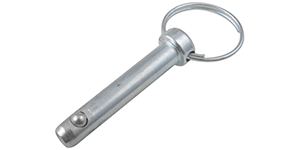
Detent pins
Contain a hallowed section of the pin with a perpendicular spring that pushes one or two ball bearings from the pin’s shaft, in order to adjust it in a hole or detent. The pin can be finger released.
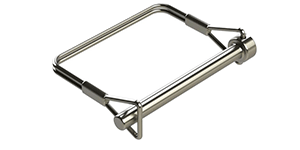
Snapper pin and tab lock pins
These self-locking pins are basically different types of hitch pins that contain an integral wire-locking device. They are ideal for when the ability to frequently connect and disconnect is desired.
Standard and certificates
We have the means to ensure our products comply the general regulation and the specific certificated regulations in manufacturing products that requires them. Such as:
- ISO 9001, ISO 14001 y OHSAS 18001
- TS 16949
We have the means to produce pins totally according to specific standards. Below just a few of the most common standards, if you need any specific standard or custom pins please contact us, we are sure that we can make it.
Dowel pins:
- ISO 8734, ISO 8735, ISO 2338…
- BS 1804…
- DIN 6325, DIN 7979, etc.
- ANSI/ASME B18.8.2
Coiled spring pins:
- Servicio standard: UNE–EN-ISO 8750, ASME B18.8.2, ASME B18.8.3M
- Pesado: UNE–EN-ISO 8748, ASME B18.8.2, ASME B18.8.3M
- Ligero: UNE–EN-ISO 8751, ASME B18.8.2, ASME B18.8.3M
Slotted spring pins:
- ISO 8752 (EN 28752)
- ASME B18.8.4M Type B (Metric), and ASME B18.8.2 (Inch)
Clevis pins:
- ISO 2340, ISO 2341
- ANSI B18.8.1
R-clip:
- DIN 11024

